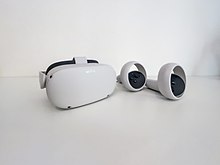
Back کوێست ٢ CKB Meta Quest 2 Czech Meta Quest 2 German Meta Quest 2 French Meta Quest 2 Japanese 퀘스트 2 Korean Oculus Quest 2 Dutch Meta Quest 2 Portuguese Oculus Quest 2 Romanian Meta Quest 2 Russian
 Oculus Quest 2 headset and its controllers | |
| Codename | "Mirimar" "Hollywood" |
|---|---|
| Also known as | Oculus Quest 2, Meta Quest 2 |
| Developer | Reality Labs |
| Type | Virtual reality headset |
| Release date | October 13, 2020 |
| Lifespan | 2020–2024 |
| Introductory price | US$299 (64 GB) US$249 (128 GB) US$399 (256 GB) |
| Discontinued | September 25, 2024 |
| Operating system | Meta Horizon OS, based on Android source code.
Original: Android 10[1] Current: Android 12.1 |
| System on a chip | Qualcomm Snapdragon XR2 |
| Memory | 6 GB LPDDR4X[2] |
| Storage | 64 GB, 128 GB, 256 GB |
| Display | RGB LCD 1832 x 1920 per eye @ 72 - 120 Hz[3] |
| Graphics | Adreno 650 @ 587 MHz (Up to 902 GFLOPS FP32)[4][5][6] |
| Sound | 2 built in speakers / 2 built in microphones / 3.5mm headphone jack |
| Input | 6DOF inside-out tracking through 4 built-in cameras and 2 controllers with accelerometers and gyroscopes |
| Controller input | Oculus Touch |
| Camera | 4 infrared cameras |
| Connectivity | |
| Online services | Quest Store |
| Weight | 503 g (17.7 oz) |
| Predecessor | Oculus Quest |
| Successor | Meta Quest 3 Meta Quest 3S |
| Website | Official website |
| This article is part of a series about |
| Meta Platforms |
|---|
 |
| Products and services |
| People |
| Business |
Quest 2 is a standalone virtual reality headset developed by Reality Labs, a division of Meta Platforms. It was unveiled on September 16, 2020, and released on October 13, 2020 as the Oculus Quest 2. It was then rebranded as the Meta Quest 2 in 2022, as part of a company-wide phase-out of the Oculus brand following the rebranding of Facebook, Inc. as Meta.
It is an evolution of the original Oculus Quest with a similar design, but with a lighter weight, updated internal specifications, a display with a higher refresh rate and per-eye resolution, and updated Oculus Touch controllers with improved battery life. As with its predecessor, the Quest 2 can run as either a standalone headset with an internal, Android-based operating system, or with Oculus Rift-compatible VR software running on a personal computer.
The Quest 2 received mostly positive reviews as an incremental update to the Quest, but some of its changes faced criticism, including its stock head strap, reduced interpupillary distance (IPD) options, and a new requirement for users to log in with a Facebook account to use the headset and Oculus services. The Quest 2 was succeeded by the Meta Quest 3 in 2023, but remained in production as a lower-cost model until September 2024, when it was replaced at the same price point by the Meta Quest 3S.
- ^ "Introducing Oculus Quest 2, the Next Generation of All-in-One VR | Oculus". developer.oculus.com. Retrieved September 24, 2020.
- ^ a b "Oculus Quest 2 Full Specs: 'Nearly 4K' 90Hz LCD, XR2 Chip, 256GB Option, 3-Step IPD, $299". UploadVR. July 16, 2020. Retrieved July 17, 2022.
- ^ "Introducing Oculus Air Link, a Wireless Way to Play PC VR Games on Oculus Quest 2, Plus Infinite Office Updates, Support for 120 Hz on Quest 2, and More". Oculus Blog. Oculus. April 13, 2021. Retrieved April 19, 2021.
- ^ "vr-compare". www.vr-compare.com.
- ^ "GPU GFLOPS Calculation". azcalculator.com.
- ^ "CPU and GPU levels". meta.com.